Westwind 24 paceship
The westwind 24 paceship is a 23.92ft masthead sloop designed by ted hood and built in fiberglass by paceship yachts ltd. since 1966..
The Westwind 24 paceship is a heavy sailboat which is a reasonably good performer. It is very stable / stiff and has a good righting capability if capsized. It is best suited as a coastal cruiser.
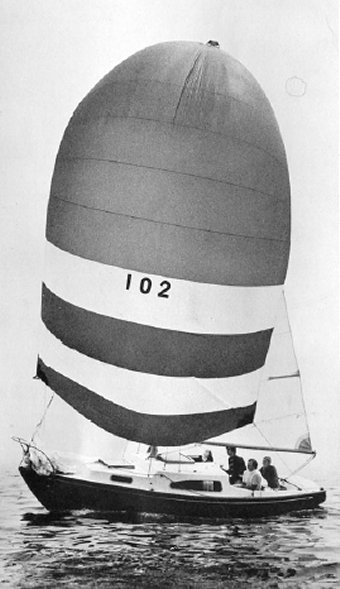

Westwind 24 paceship for sale elsewhere on the web:

Main features
Login or register to personnalize this screen.
You will be able to pin external links of your choice.

See how Sailboatlab works in video

We help you build your own hydraulic steering system - Lecomble & Schmitt
Accommodations
Builder data, other photos.
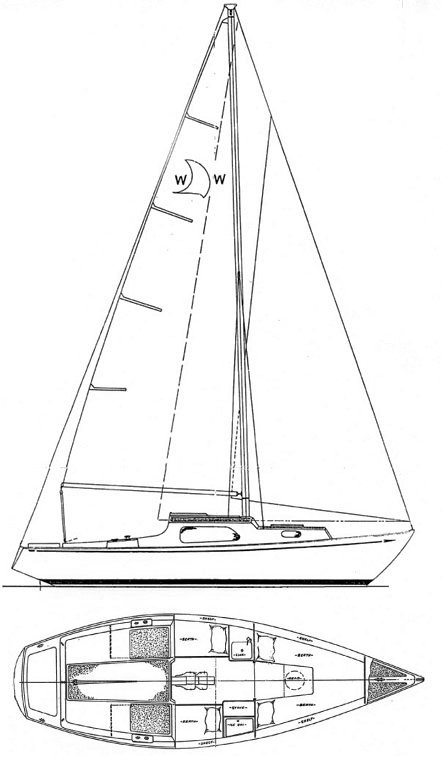
Modal Title
The content of your modal.
Personalize your sailboat data sheet
Review of Westwind 24
Basic specs., sailing characteristics.
This section covers widely used rules of thumb to describe the sailing characteristics. Please note that even though the calculations are correct, the interpretation of the results might not be valid for extreme boats.
What is Capsize Screening Formula (CSF)?
The capsize screening value for Westwind 24 is 1.91, indicating that this boat could - if evaluated by this formula alone - be accepted to participate in ocean races.
What is Theoretical Maximum Hull Speed?
The theoretical maximal speed of a displacement boat of this length is 5.7 knots. The term "Theoretical Maximum Hull Speed" is widely used even though a boat can sail faster. The term shall be interpreted as above the theoretical speed a great additional power is necessary for a small gain in speed.
The immersion rate is defined as the weight required to sink the boat a certain level. The immersion rate for Westwind 24 is about 89 kg/cm, alternatively 502 lbs/inch. Meaning: if you load 89 kg cargo on the boat then it will sink 1 cm. Alternatively, if you load 502 lbs cargo on the boat it will sink 1 inch.
Sailing statistics
This section is statistical comparison with similar boats of the same category. The basis of the following statistical computations is our unique database with more than 26,000 different boat types and 350,000 data points.
What is Motion Comfort Ratio (MCR)?
What is L/B (Length Beam Ratio)?
What is Displacement Length Ratio?
What is SA/D (Sail Area Displacement ratio)?
Maintenance
Are your sails worn out? You might find your next sail here: Sails for Sale
If you need to renew parts of your running rig and is not quite sure of the dimensions, you may find the estimates computed below useful.
This section shown boat owner's changes, improvements, etc. Here you might find inspiration for your boat.
Do you have changes/improvements you would like to share? Upload a photo and describe what to look for.
We are always looking for new photos. If you can contribute with photos for Westwind 24 it would be a great help.
If you have any comments to the review, improvement suggestions, or the like, feel free to contact us . Criticism helps us to improve.
Not logged in
- Create account
Engineering:Westwind 24
- Engineering
Page actions
- View source
The Westwind 24 , also called the Paceship P 24 , is a Canadian trailerable sailboat that was designed by Ted Hood as a cruiser and first built in 1966. [1] [2] [3]
- 1 Production
- 3 Operational history
- 5 References
The design was built by Paceship Yachts in Canada , starting in 1966, but it is now out of production. [1] [3] [4]
The Westwind 24 is a recreational keelboat , built predominantly of fibreglass, with wood trim. It has a masthead sloop rig; a spooned, raked stem; a raised counter, reverse transom, an internally mounted spade-type rudder controlled by a tiller and a fixed, rounded long keel with a retractable centreboard . It displaces 4,630 lb (2,100 kg) and carries 2,370 lb (1,075 kg) of lead ballast. [1] [3]
The boat has a draft of 5.50 ft (1.68 m) with the centreboard extended and 2.10 ft (0.64 m) with it retracted, allowing operation in shallow water or ground transportation on a trailer . [1] [3]
The boat is normally fitted with a small 3 to 6 hp (2 to 4 kW) outboard motor for docking and manoeuvring. The motor is mounted in a well in the lazarette. [1] [3]
The design has sleeping accommodation for four people, with a double "V"-berth in the bow cabin and two straight settee berths in the main cabin. The galley is located on both sides, just aft of the bow cabin. The galley is equipped with a sink to port and an ice box to starboard. The head is located in the bow cabin under the "V"-berth. Cabin headroom is 66 in (168 cm) and the fresh water tank has a capacity of 12 U.S. gallons (45 L; 10.0 imp gal). [1] [3]
For sailing downwind the design may be equipped with a symmetrical spinnaker . [1] [3]
The design has a PHRF racing average handicap of 231 and a hull speed of 5.7 kn (10.6 km/h). [3]
Operational history
The boat was at one time supported by an active class club, The Paceship , but since the death of the club organizer the club is inactive, pending efforts to restart it. [5] [6]
In a 2010 review Steve Henkel wrote, "Ted Hood founded Hood Sailmakers, which during the 1960s turned into the world's largest sailmaker. Also in the 1960s he began designing yachts, and eventually became a boatbuilder, founding Little Harbor Yachts. In 1967 he designed the deep-bellied whalelike hull you see here for Paceship Yachts of Mahone Bay, Nova Scotia. The design may look unconventional, but close inspection reveals some advantages. Above the waterline, the hull is quite conventional, but the lower midships section descends into a deep V down where ballast is most effective ... The hull depth also permits a lower cabin sole which together with a doghouse in the cabintop yields the most headroom compared to her comp[etitor]s. Best features: In general, owners seem quite satisfied with their choice of boat. Worst features: Despite her good headroom, plus cabin cabin sides which are very close to the gunwales (leaving very little room to walk forward), the boat has a lower Space Index than any of her comp[etitor]s." [3]
- List of sailing boat types
- ↑ 1.0 1.1 1.2 1.3 1.4 1.5 1.6 McArthur, Bruce (2021). "Westwind 24 (Paceship) sailboat" . sailboatdata.com . https://sailboatdata.com/sailboat/westwind-24-paceship .
- ↑ McArthur, Bruce (2021). "Ted Hood 1927 - 2013" . sailboatdata.com . https://sailboatdata.com/designer/hood-ted .
- ↑ 3.0 3.1 3.2 3.3 3.4 3.5 3.6 3.7 3.8 Henkel, Steve: The Sailor's Book of Small Cruising Sailboats , page 302. International Marine/McGraw-Hill, 2010. ISBN :978-0-07-163652-0
- ↑ McArthur, Bruce (2021). "Paceship Yachts Ltd. 1962 - 1981" . sailboatdata.com . https://sailboatdata.com/builder/paceship-yachts-ltd .
- ↑ McArthur, Bruce (2021). "Paceship/AMF Yachts Website" . sailboatdata.com . https://sailboatdata.com/association/paceshipamf-yachts-website .
- ↑ "The Pacehip" . paceship.org . http://www.paceship.org/ . "We’re working on reactivating the webpages of Paceship.ORG and the related domains. The creator, Jay Moran, passed and through the kindness of his daughter, the site has been saved. The domains have been moved and we have a copy of the Windows server files."
- Sailing yachts
- Trailer sailers

- Add a new article
- Search in all topics
- Search in namespaces
- Search in categories
- Search using prefix
- About HandWiki
- How to edit
- Citation manager
- Formatting articles
- List of categories
- Recent pages
- Recent changes
- Random page
- Support & Donate
- Special pages
- Cite this page
User page tools
- What links here
- Related changes
- Printable version
- Permanent link
- Page information
Other projects
In other languages.
- This page was last edited on 25 June 2023, at 11:48.
- Privacy policy
- Disclaimers
Home > Find Your Sail > Search by Make and Model > Paceship > Paceship 24 Westwind
Paceship 24 Westwind
" * " indicates required fields
Step 1 of 3
Let's Get to Know Each Other
Let's connect, why it's important to partner with a designer on your paceship 24 westwind sail.
The design is the most critical part of your new sail. Ensuring the sail fits and performs its best is a must for our crew. The Precision Sails Design team are experts at their craft. Unlike other sail lofts all of our sailors work one-on-one with a designer to perfect their Paceship 24 Westwind sail.
No Two Paceship 24 Westwind Sails Are Alike
There are many factors that affect the performance and design of your sails. Location, sailing experience, and weather conditions all come into play when picking the perfect sail. Two mainsails made for two Paceship 24 Westwind’s in California and Florida will have different designs, sailcloth, and options based on what is best for the sailor.
Taking measurements is easy. All sailors work alongside our measurement team to measure and confirm their rig specs. This helps ensure your design is flawless and allows us to extend our Perfect Fit Guarantee to all of our sailors.
Discover the best cloth for your sailing needs, our sail details, or more about how Precision Sails is leading the sail-making industry with innovative new practices.
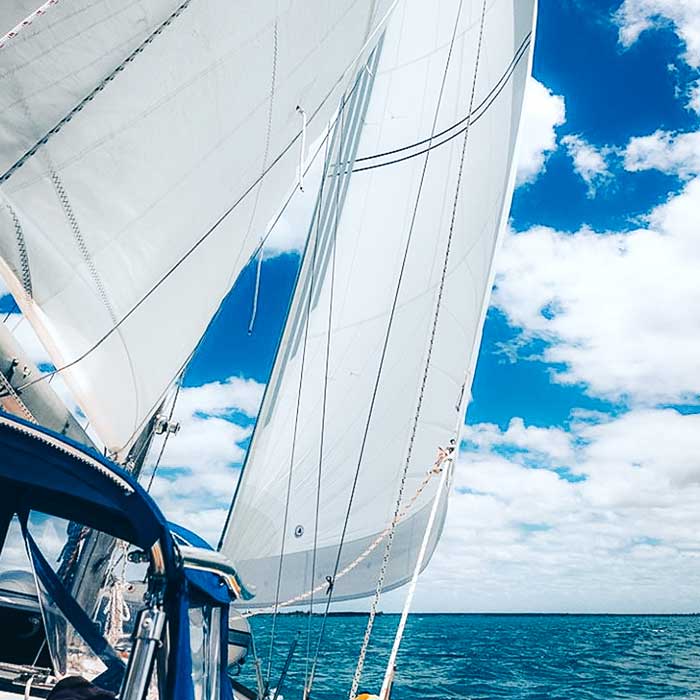
Proudly offering the largest selection of sailcloth in the industry, our team is always available to help you find your perfect sail. Whether you're a weekend sailor, coastal cruiser, or club racer our team is ready to walk you through the process.
Types of Sails
Precision Sail Loft specializes in producing headsails, mainsails, spinnakers, gennakers, and code zeros. So no matter the type of sail you’re looking for, we can help. Our sails are trusted by cruisers and racers alike from around the globe. Review the sail options and craftsmanship available to customize your dream sail.
Build & Process
Every sail we craft is produced to the highest standards with the best hardware, craftsmanship, and skill-set in the industry. Pair that with Precision Sails' approach to communication and your sailboat will be ready to set sail before you know it.
Unparalleled Commitment To Helping Sailors
As experts in design, communication, and production our team is ready to take on the task of making sails for your boat. Give us a call to get started.
“ I just received my asymmetrical spinnaker, with sock and turtle bag, along with a new 135 Genoa. The entire process was simple and both sales and the design team were in regular contact if there were any questions. The customer portal was easy to use and lets you keep track of where in the process your sails are. Great sails, great service -Graham Edwards (Facebook)
“ The whole team at Precision Sails was fantastic from start to finish. We’ve had a laminate main and genoa made so far and have a spinnaker on the way. They listened carefully to our needs and recommended a great sail cloth. We couldn’t have gotten more bang for our buck! -Noah Regelous (Google)
“ We received our spinnaker and launched it yesterday and I just wanted to let you know how pleased we are with it. The service we received from your company was exceptional and the quality of your product is second to none. We will certainly be return customers in the next few months to replace our main and jib sails and will recommend your company to all our sailing buddies. Once again-thank you.” -Daniel Jackson (Google)
“ we had good communication during the planning stages and the knowledgeable people at precision sails really got me fixed up good! The sails look and work fabulous! my boat sails better than it ever had! couldn’t be more pleased with the product AND the service!” -Fred Jelich (Facebook)
“ Our new furling jib for a Corsair 27 Had to be specially designed due to the height of the furler, but this was accomplished quickly and in short order we had our sail which fits beautifully and has a great shape. It’s everything we could have wanted, high tech design, thoughtfully executed and affordable.” -Nancy Y. (Yelp)
Request a Paceship 24 Westwind Quote
Looking to buy a new headsail or mainsail for your Paceship 24 Westwind? Request a free quote from Precision Sails for a new custom sail. Our team will work with you to design the perfect sail for you.
- New Sailboats
- Sailboats 21-30ft
- Sailboats 31-35ft
- Sailboats 36-40ft
- Sailboats Over 40ft
- Sailboats Under 21feet
- used_sailboats
- Apps and Computer Programs
- Communications
- Fishfinders
- Handheld Electronics
- Plotters MFDS Rradar
- Wind, Speed & Depth Instruments
- Anchoring Mooring
- Running Rigging
- Sails Canvas
- Standing Rigging
- Diesel Engines
- Off Grid Energy
- Cleaning Waxing
- DIY Projects
- Repair, Tools & Materials
- Spare Parts
- Tools & Gadgets
- Cabin Comfort
- Ventilation
- Footwear Apparel
- Foul Weather Gear
- Mailport & PS Advisor
- Inside Practical Sailor Blog
- Activate My Web Access
- Reset Password
- Pay My Bill
- Customer Service

- Free Newsletter
- Give a Gift

Ericson 34-2 Finds Sweet Spot

How to Sell Your Boat

Cal 2-46: A Venerable Lapworth Design Brought Up to Date

Rhumb Lines: Show Highlights from Annapolis

Leaping Into Lithium

The Importance of Sea State in Weather Planning

Do-it-yourself Electrical System Survey and Inspection

Install a Standalone Sounder Without Drilling

When Should We Retire Dyneema Stays and Running Rigging?

Rethinking MOB Prevention

Top-notch Wind Indicators

The Everlasting Multihull Trampoline

Check Your Shorepower System for Hidden Dangers

DIY survey of boat solar and wind turbine systems

What’s Involved in Setting Up a Lithium Battery System?

The Scraper-only Approach to Bottom Paint Removal

Can You Recoat Dyneema?

Gonytia Hot Knife Proves its Mettle

How to Handle the Head

The Day Sailor’s First-Aid Kit

Choosing and Securing Seat Cushions

Cockpit Drains on Race Boats

Re-sealing the Seams on Waterproof Fabrics

Safer Sailing: Add Leg Loops to Your Harness

Waxing and Polishing Your Boat


Reducing Engine Room Noise

Tricks and Tips to Forming Do-it-yourself Rigging Terminals

Marine Toilet Maintenance Tips

Learning to Live with Plastic Boat Bits
- Sailboat Reviews
Four Trailer-Sailers And the Keel/Launch Problem
The paceship 23, american 26, yankee pacific dolphin 24, and aquarius 23 represent different solutions to the problem of easy launching.
In the early 1970s, when the fiberglass sailboat revolution was in full swing, so were the so-called swing keels. Three years after Richard Nixon was elected president, partly on the promise of ending the Vietnam War, U.S. planes still were bombing Cambodia, hippies and peaceniks were marching and both were flashing the V sign. In 1971 Sylvia Plath published “The Bell Jar,” Louis Armstrong died, the crews of Apollo 14 and 15 landed on the moon, cigarette advertisements were banned from television, and Joe Frazier outpointed Muhammad Ali to retain his world heavyweight boxing title.
On the domestic level, Americans were taking their leisure time more seriously than ever, taking to the highways in RVs and to the waterways in all sorts of new fiberglass boats. Magazines devoted exclusively to sailing began to appear. One of the most popular type of boats was the “trailersailer,” relatively light-displacement sloops with centerboards and swing keels, that could be stored in the backyard or driveway, towed behind the family station wagon and launched in about 45 minutes. Trailer-sailers promised yacht-style accommodations at an affordable price-in terms of both initial investment and annual upkeep.
Trailer-sailers never really disappeared from the sailing scene, but they haven’t been exactly an exploding market force either. But becuase we see indications that trailer-sailers are showing signs of increased interest from boat buyers, we thought we’d take a look at four early-and mid-19702 designs.
The Ballast Problem
For stability, a sailboat must have an underwater appendage such as a keel or centerboard, and ballast. Both are at odds with the concept of an easily trailerable boat that can be launched at most ramps. A deep fixed keel is untenable. One solution is to design a long, shallow keel, as seen on many Com-Pac boats, and older models such as the O’Day22. Unfortunately, windward performance suffers because there is little leading edge and foil shape to provide lift.
During the last few years, several builders have experimented with water ballast in the hull and centerboards for lift. Notable designs include the MacGregor 26, Hunter 23.5 and 26, and the new Catalina 25. The idea is to dump the ballast on haul-out to minimize trailering weight, especially important given the small size of the average car these days. The drawback, as we see it, is that the water ballast works best when it is well outboard, which is the case on race boats with port and starboard ballast tanks. Trailer-sailers with shallow ballast tanks on centerline can’t obtain the same righting moments because of the short righting arm. Plus, saltwater is not very dense, just 64 pounds per cubic foot (62.4 lbs. for fresh), compared to lead at about 708 lbs. While waterballast may be a viable option for lake and protected-water sailors, we don’t think it’s the best solution.
Looking back at the Paceship PY 23, American 26, Yankee Dolphin24, and Aquarius 23-we can examine several other approaches to the same problem.
Paceship Yachts was originally a Canadian builder, located in Mahone Bay, Nova Scotia (it was later bought by AMF of Waterbury, Connecticut). One of its first boats was the popular East Wind 24, introduced in 1963. The PY 23, designed by John Deknatel of C. Raymond Hunt Associates, was developed in 1974 in response to the trailer-sailer boom.
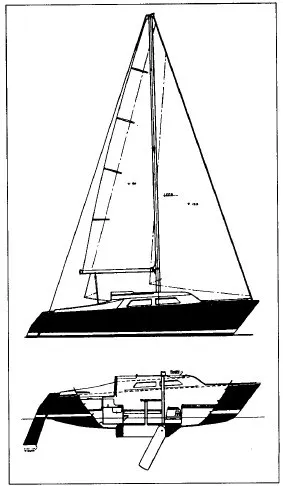
An early brochure describes the PY 23 as “a second generation refinement of the trailerable concept which eliminates the awkwardness in handling and sailing often present in the early trailerables.” Indeed, the boat was rated 18.0 for IOR Quarter Ton and 16. 9 under the MORC rule. Modern looks were derived largely from the flat sheer and reverse transom.
Instead of the more common swing keel, in which all of the boat’s ballast hangs on a single pivot pin, Deknatel gave the PY 23 a 40-pound centerboard that retracts into a 900-pound “shallow draft lineal keel.” This arrangement eliminates a trunk intruding into the cabin space, and places the majority of ballast a bit lower (it draws 1′ 9″ board up) than in boats, such as the Aquarius 23, in which the ballast is simply located under the cabin sole. The downside is a bit more draft, which means you need to get the trailer that much deeper to float the boat on and off. (We once owned a Catalina 22, which draws 2′ 0″ keel up, and often had to use a trailer tongue extension-built in-to launch and haul out.) Based on our experience, any draft under 2 feet should be relatively easy to trailer and launch. Difficulties seem to mount exponentially with every inch of added draft.
Like most trailer-sailers, the PY 23 has an outboard rudder that kicks up for beaching.
Recognizing that trailer-sailers are not built for rugged conditions, and that by necessity they are not big boats, we herewith list some of the more common owner complaints: no backrests in cabin, barnacles in centerboard well, not enough room in head, not an easily trailerable boat, rudder rot, and poor ventilation in forepeak.
On the plus side, owners say the boat is quick, well built, balances well, has good-quality mast and rigging, a comfortable cockpit, and a livable interior.
In all, we think this is a good example of the trailer-sailer. We like the keel/centerboard arrangement, even though it adds a few precious inches to board-up draft. It sold in 1974 for $8,150 base. Today, it would sell for about $5,100. A superior choice in our book.
Yankee Pacific Dolphin 24
Yankee Yachts of Santa Ana, California, was a major builder during the 1970s, known mostly for its IOR boats. The Pacific Dolphin 24, designed by Sparkman & Stephens, is a classiclooking boat, not unlike the more familiar S&S-designed Tartan 2 7. It was built between about 1969 and 1971, when it was replaced by the Seahorse 24, designed by Robert Finch, who helped design the immensely successful Catalina 27.
The reason, we surmise, was that the Dolphin has a long keel drawing 2′ 10″, and though the company initially thought it would appeal to trailersailers, it’s draft, plus 4,250-pound displacement, made it difficult to launch and retrieve. In contrast, the Seahorse drew 1′ 8″, displaced 2,800 pounds, and has a scabbard-type removable rudder.
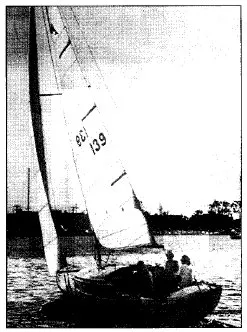
The Dolphin has 1,750 pounds of ballast, all in the keel. The attached rudder makes this boat a bit more rugged than most trailer-sailers, and its overall quality, including extensive teak joinerwork below, places it in a different category.
Owners report very few problems with the Dolphin other than a comparatively large turning radius, and cramped living quarters; most have only good things to say. An Oregon owner said, “Using a 3/4-ton pickup with a 390 engine we go uphill at 30 mph and down at 55. It takes us a couple of hours to rig and get underway, but it sure beats paying slip fees.” He also cites the Dolphin’s speed, saying he keeps pace with a Cal34, trounces a Balboa 26 and Catalina 27, and has only “lost” to a San Juan 21 going upwind. A Washington owner says she is very seakindly, with just the right amount of helm, though a bit tender due to narrow beam. Most owners use a 6-hp. outboard in the well, though one said he opted for a 15-hp. outboard for better performance, and because it can charge the batteries. Construction is reported as heavy.
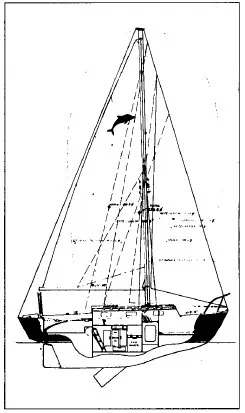
In 1971 the boat sold new for $5,995.Prices now are around $7,500, which for an original owner would have made it the best investment of these four boats. While we have always liked the Dolphin, we don’t view it as suitable for regular trailering. More likely, you’d keep it at a slip during the sailing season, parking it at home on its trailer after haul-out.
American 26
Costa Mesa, California was the epicenter of 1970s boatbuilding. American Mariner Industries is one company, however, better forgotten. It was in business from about 1974 to 1983. Its American 26 was a 25 first. A 1974 brochure says, “This 25-footer so completely justified our judgment as to the efficacy of our unique stabilizer keel and hull . . . that we have moved on to provide the trail-and-sail cruising enthusiast with a choice of two versions-the American 23 and the American 26.” This seems to imply that the same hull mold was used.
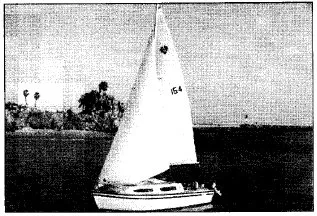
In any case, what is unique about this line of boats is the wide, partly hollow keel that makes a sort of trough in the cabin sole to provide standing headroom. It is not wide, but does run nearly the length of the main cabin. Ballast is 900 pounds of lead laid in the bottom of the keel. Draft is 2′ 4″ for trailerability, but there is no centerboard, and due to the keel’s extreme width, you can imagine that windward performance is poor. Unfortunately, we have no owner feedback on this boat to corroborate our assessment.
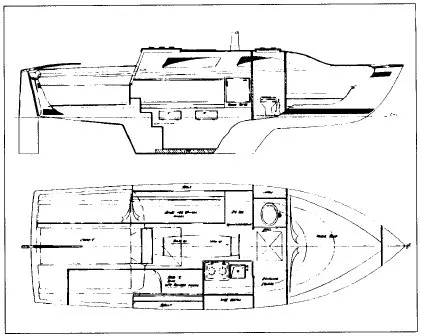
The boat sold new in 1974 for $8,995 base. The BUC Research Used Boat Price Guide says today it’s worth about $6,000. Frankly, this design, which severely compromises sailing performance for standing headroom, seems ill-conceived. One can only guess at how many people have cracked their skulls stepping up out of the trough.
Aquarius 23
Coastal Recreation, Inc., also of Costa Mesa, was around from about 1969 to 1983. It acquired the Balboa line of trailer-sailers, and for a time built the LaPaz 25 motorsailer.
The Aquarius 23, and its smaller sistership the Aquarius 21, were designed by Peter Barrett, a Webb Institute graduate and national champion in Finns and 4 70s. The Aquarius 23 is not much prettier to look at than the American 26, though it sails surprisingly well. Because highway trailering laws restrict the beam to 8 feet, the Aquarius 23 comes in just under at 7′ 11″ and relies on it for stability. ” Most of the 815 pounds of ballast is in the hull. A large center- board retracts fully into a trunk, which is more or less concealed in the cabin as a foundation for the drop-leaf table. A peculiarity is that persons sitting at the table are all on the starboard side, and the forward person is forward of the main bulkhead, essentially in the head, though there is a fore-andaft bulkhead making the toilet reasonably private (another important issue for trailersailers).
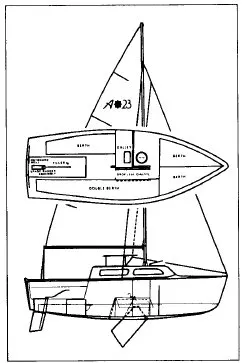
Like the Paceship PY 23 and many other trailer-sailers, the Aquarius 23 has a pop-top to provide additional headroom. We think this is more sensible than the American’s keel trough, but we do caution that pop tops can leak and aren’t designed for offshore use.
Another unusual feature of the Aquarius is the absence of a backstay and spreaders. To support the mast, the shrouds are led aft, reflecting, we suppose, Barrett’s one-design background. If not suited for wild and woolly sailing conditions, it is at least simple to set up, and that, after all, is the goal of most trailer-sailers.
Friends of ours bought an Aquarius 23 in 1970, and we spent a good deal of time sailing with them, including several overnight crossings of Lake Michigan. The boat handled well, was reasonably quick on a reach, and had more interior room than most 23-footers. Still, we were never enamored of its looks.
Complaints from owners include lost centerboards and rudder repairs (like the Yankee Seahorse, it is an inside, removable type), poor ventilation, poor windward performance when overloaded, tubby appearance, and lack of a mainsheet traveler. Many owners say they bought the boat for its shoal draft and large interior, but that cheap construction caused numerous problems.
The Aquarius 23, in the early 1970s, sold for $6,195; today it sells for about $4,000. Though our memories of sailing this boat are all rosy, we think there are better boats available.
Our preferred solution to the keel/ ballast problem in trailer-sailers is the traditional keel/centerboard as found on the PY 23, Tanzer22 andO’Day23, all of which we recommend. The keel/ centerboard configuration eliminates the trunk in the cabin, places ballast below the hull, and does not concentrate all of the ballast weight on a pivot pin, as is the case with swing-keel designs.
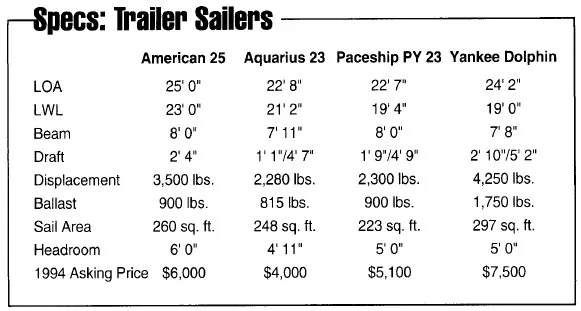
We do not care for the American 26’s hollow keel, believing that if you want standing headroom, either go outside or buy a bigger boat. Nor do we care particularly for narrow shoal keels without centerboards, because windward performance suffers, or boards that leave all the ballast in the hull-whether lead, iron or water-as ultimate stability is compromised.
How one solves the choice between interior space and sailing performance is a personal decision. We, too, appreciate spaciousness down below, but at the same time have always chosen boats that looked and sailed decently, willing to give up a few inches of elbow room for a boat we could feel proud of when rowing away in the dinghy.
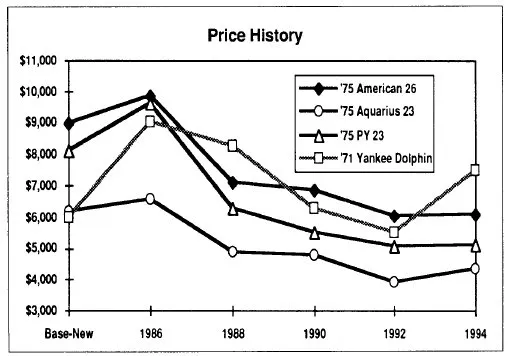
RELATED ARTICLES MORE FROM AUTHOR
So the only real complaint against the Aquarius23 is the author is not “enamoured” with it’s “looks”, whatever that means.
I think the Aquarius 23 beats them all for what they were designed for. A family of 5 and thats just what I have. The wide stern and blunt bow make it Large inside and can take a lot of wieght in the tail. I need function, rugged keel for beaching and shallow waters.
I had an Aquarius 21 for thirteen years in San Diego. I sailed it all the time, and made four trips to Catalina Island in it. It had some poor constructions flaws (like particle board coring for the deck), but it was inexpensive, and easily handled by one person. I loved it.
Hi Kevin. I’m looking at a Aquarius 21 project boat. The owner lost the title so I would have to re-title it, but can find a VIN / serial # anywhere. Can you tell me where it might be located?
I have owned and sailed a PY 23 for twenty years, and she has served me well. I have had off and on trouble lowering the centerboard, as it easily sticks in the up position (likely due to growths inside the trunk). It is difficult to gain enough leverage from inside the cabin to force it down. Other than that – the boat has been a trooper.
Have you ever evaluated the Sirius 21/22?
How about a review of the Sirius 21/22 by Vandestad and McGrewer?
LEAVE A REPLY Cancel reply
Log in to leave a comment
Latest Videos

40-Footer Boat Tours – With Some Big Surprises! | Boat Tour

Electrical Do’s and Don’ts

Bahamas Travel Advisory: Cause for Concern?

Island Packet 370: What You Should Know | Boat Review
- Privacy Policy
- Do Not Sell My Personal Information
- Online Account Activation
- Privacy Manager


- Forums New posts Unanswered threads Register Top Posts Email
- What's new New posts New Posts (legacy) Latest activity New media
- Media New media New comments
- Boat Info Downloads Weekly Quiz Topic FAQ 10000boatnames.com
- Classifieds Sell Your Boat Used Gear for Sale
- Parts General Marine Parts Hunter Beneteau Catalina MacGregor Oday
- Help Terms of Use Monday Mail Subscribe Monday Mail Unsubscribe
- Thread starter JonP
- Start date Aug 30, 2014
- Forums for All Owners
- Ask All Sailors
hello. I was wondering if any ones got info on a '63 paceship oakisland p12 sail boad I was reasently given one and im wanting some info on them even pictures also...... - where would I find new stainless steel cable (believe they are called shrouds). and are they universal sorta thing - and what sort of paint do I have to use or can I use automotive paint thx in advance jon
I had a '64 Paceship Eastwind 25 for quite a few years. Is this the model you have. They also built a like a 20' and 29' ketch. This is what the Eastwind looks like: http://www.paceship.org/model_boat.asp?model_ID=19
Shrouds/stays should be made by a local rigger who measures your boat and specs the material. Paint type depends on what and where you are painting. Please advise for a better response.
my father and I did some further digging and I believe I have a Phi do to the haul and pictures ive found on line but the ID plate says Oakland
I believe I added some pictures if I did it worked
If no one had answered yet, you can buy the stainless steel wire for the shrouds in a marine hardware store, or probably on this website. What is most often used is 1 by 19 stainless wire which is stiff and strong. This can be had for between $1 and $2 per foot. So, measure carefully. There are other alternatives but 1 by 19 stainless is the most common. I can't specify a size but there are tables which can or a chandlery such as this site can. You'll spend more money on the connections of the wire to turnbuckles or other hardware than on the wire itself. So these jobs require careful planning and measurement. Paint is another matter. What are you painting? This isn't really my area. There are real experts in painting on this forum. They will chime in.
Usually when ordering new standing rigging, the best thing to do is send the old rigging into whoever is making the new wire. No measuring needed by you. They simply fashion new wire that is the same as the old.
Painting shemandr. im wanting to paint the top side and bottom side. fiberglass. from what info ive been told and gathered if the boad comes out every time it goes in i can use top side paint on the bottom
While cruising Nove Scotia this summer we saw the former paceship facility in Mahone bay and the current ABCO facility in Lunenburg which still producs boats. The one they were parading aroundd the harbor when we were there was a mid 20s center console.
Does anyone know what happened to the Paceship Owners Group? It had some great info. I had read somewheres that it had been saved as a PDF? Anyone have any info?
Paceship.org
working on bringing it back to life. Paceship.org Asking the Admins here about creating a dedicated forum section here as it seems a good place to centralize things.
kappykaplan
Paceship.org said: working on bringing it back to life. Paceship.org Asking the Admins here about creating a dedicated forum section here as it seems a good place to centralize things. Click to expand
kappykaplan said: Calling @Dave Click to expand
- This site uses cookies to help personalise content, tailor your experience and to keep you logged in if you register. By continuing to use this site, you are consenting to our use of cookies. Accept Learn more…
LIVE UPDATES
Baltimore Key Bridge collapse live updates: Search and rescue efforts suspended
A container ship struck Baltimore's Francis Scott Key Bridge early Tuesday.
A cargo ship crashed into Baltimore's Francis Scott Key Bridge early Tuesday morning, causing a near-total collapse of the span and halting vessel traffic into and out of the Port of Baltimore.
A search-and-rescue effort for six people believed to have fallen from the collapsing bridge into the frigid waters of the Patapsco River below has been suspended and will shift to a recovery mission, officials said.
Latest headlines:
Workers from guatemala, el salvador among missing.
- Personnel on ship alerted officials before collision 'which undoubtedly saved lives': Biden
- No cars transiting bridge at time of collapse: Internal DHS briefing
- 6 unaccounted for
What to know about the collapse
The container ship Dali struck Baltimore's Francis Scott Key Bridge at about 1:30 a.m. Tuesday, partially collapsing the bridge , officials in Maryland said.
A local pilot was at the helm of the ship at the time, Maryland Department of Transportation Secretary Paul Wiedefeld said.
The crash appeared to be accidental , not intentional, officials said.
Two people were rescued from the Patapsco River and at least six people remain missing, officials said. Search and rescue efforts for the missing individuals were suspended Tuesday evening as operations shifted to a recovery phase, officials said.
Construction workers originally from Guatemala and El Salvador are among the six missing after the Key Bridge collapsed in Baltimore, foreign officials and local aid group said.
The two from Guatemala who are missing are a 26-year-old from San Luis, Petén, and a 35-year-old from Camotán, Chiquimula, the country's foreign ministry said in a statement . Their names were not released.
Another missing worker was identified as Miguel Luna, who is originally from El Salvador, according to Court Appointed Special Advocates, a group that works with immigrants.
"Miguel Luna, from El Salvador, left at 6:30 p.m. Monday evening for work and since, has not come home," the organization said in a press release . "He is a husband, a father of three, and has called Maryland his home for over 19 years."
-ABC News’ Victoria Arancio and Kevin Shalvey
Search and rescue efforts to be suspended, move to recovery operation: USCG
The Coast Guard said it is suspending the search and rescue efforts as of 7:30 p.m. Tuesday for the six missing individuals after the bridge collapse.
"Based on the length of time that we've gone in the search, the extensive search efforts that we put into it, the water temperature -- at this point, we do not believe that we're going to find any of these individuals still alive," Rear Admiral Shannon Gilreath told reporters.
Baltimore bridge collapse: Search and rescue efforts suspended, Coast Guard says
The conditions in the water, including low water temperatures and unpredictable currents, have made it dangerous for first responders, authorities said.
Authorities said they plan to conduct recovery efforts starting at 6 a.m. on Wednesday.
"We're hoping to put divers in the water and begin a more detailed search to do our very best to recover those six missing people," Col. Roland Butler with the Maryland State Police said.
Carnival temporarily moving Baltimore operations to Norfolk
Carnival is temporarily moving its Baltimore operations to Norfolk, Virginia, amid the rescue and remediation efforts following the bridge collapse, the cruise line said Tuesday.
"Our thoughts remain with the impacted families and first responders in Baltimore," Christine Duffy, president of Carnival Cruise Line, said in a statement. "We appreciate the pledge made by President Biden today to dedicate all available resources to reopen Baltimore Harbor to marine traffic as soon as possible. As those plans are finalized, we will update our future cruise guests on when we will return home to Baltimore, but in the meantime, we appreciate the quick response and support from officials in Norfolk."
The move impacts the Carnival Legend ship, which is scheduled to return from its current voyage on Sunday, the company said. The cruise will return to Norfolk with free bus service back to Baltimore, Carnival said.
EPA on standby, not aware of any concerns
The regional office of the Environmental Protection Agency is on standby to respond to the aftermath of the bridge collapse if needed but is not aware of any environmental concerns at this time, according to EPA Mid-Atlantic Public Affairs spokesman Shaun Egan.
Synergy Marine Group said Tuesday morning that there was no pollution from the ship.
The Coast Guard is the primary federal agency responding and they have not asked for EPA assistance. Coast Guard pollution responders were sent to the scene, and if any releases of fuel or other pollutants are detected, the EPA official said the agency is ready to support that response.
The Maryland Department of the Environment said it is "conducting water sampling upriver and downriver of the site."
-ABC News’ Stephanie Ebbs and Beatrice Peterson
Top Stories
Baltimore bridge collapse live updates: search and rescue efforts suspended, what we know about the baltimore bridge collapse, 2 guatemalans, 1 salvadoran among missing from baltimore bridge collapse, 'heroic': traffic onto baltimore key bridge halted before collapse, rfk jr. names lawyer nicole shanahan as his running mate.
Great choice! Your favorites are temporarily saved for this session. Sign in to save them permanently, access them on any device, and receive relevant alerts.
- Sailboat Guide
Paceship PY 23
Paceship PY 23 is a 22 ′ 6 ″ / 6.9 m monohull sailboat designed by Raymond Hunt (C.R. Hunt & Assoc.) and John Deknatel and built by AMF Corp. and Paceship Yachts Ltd. between 1973 and 1981.
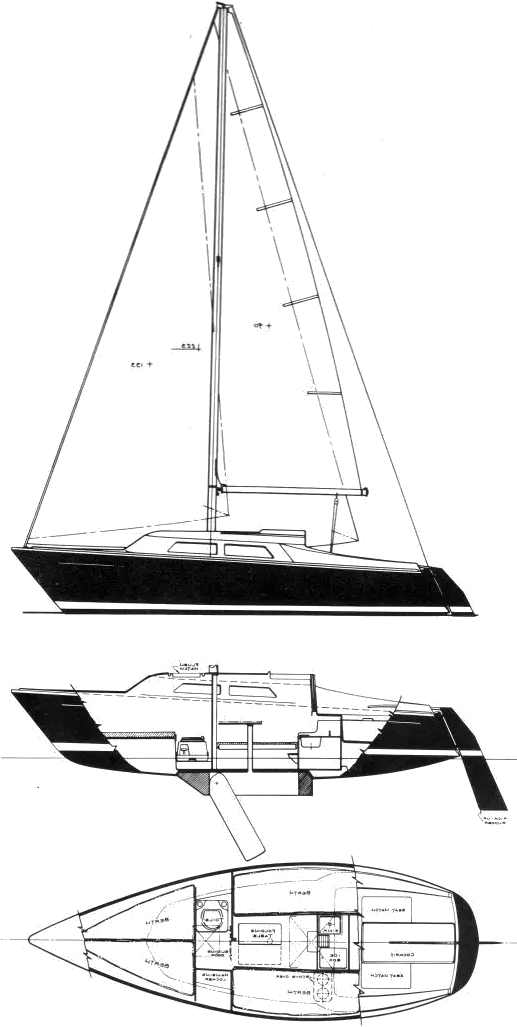
Rig and Sails
Auxilary power, accomodations, calculations.
The theoretical maximum speed that a displacement hull can move efficiently through the water is determined by it's waterline length and displacement. It may be unable to reach this speed if the boat is underpowered or heavily loaded, though it may exceed this speed given enough power. Read more.
Classic hull speed formula:
Hull Speed = 1.34 x √LWL
Max Speed/Length ratio = 8.26 ÷ Displacement/Length ratio .311 Hull Speed = Max Speed/Length ratio x √LWL
Sail Area / Displacement Ratio
A measure of the power of the sails relative to the weight of the boat. The higher the number, the higher the performance, but the harder the boat will be to handle. This ratio is a "non-dimensional" value that facilitates comparisons between boats of different types and sizes. Read more.
SA/D = SA ÷ (D ÷ 64) 2/3
- SA : Sail area in square feet, derived by adding the mainsail area to 100% of the foretriangle area (the lateral area above the deck between the mast and the forestay).
- D : Displacement in pounds.
Ballast / Displacement Ratio
A measure of the stability of a boat's hull that suggests how well a monohull will stand up to its sails. The ballast displacement ratio indicates how much of the weight of a boat is placed for maximum stability against capsizing and is an indicator of stiffness and resistance to capsize.
Ballast / Displacement * 100
Displacement / Length Ratio
A measure of the weight of the boat relative to it's length at the waterline. The higher a boat’s D/L ratio, the more easily it will carry a load and the more comfortable its motion will be. The lower a boat's ratio is, the less power it takes to drive the boat to its nominal hull speed or beyond. Read more.
D/L = (D ÷ 2240) ÷ (0.01 x LWL)³
- D: Displacement of the boat in pounds.
- LWL: Waterline length in feet
Comfort Ratio
This ratio assess how quickly and abruptly a boat’s hull reacts to waves in a significant seaway, these being the elements of a boat’s motion most likely to cause seasickness. Read more.
Comfort ratio = D ÷ (.65 x (.7 LWL + .3 LOA) x Beam 1.33 )
- D: Displacement of the boat in pounds
- LOA: Length overall in feet
- Beam: Width of boat at the widest point in feet
Capsize Screening Formula
This formula attempts to indicate whether a given boat might be too wide and light to readily right itself after being overturned in extreme conditions. Read more.
CSV = Beam ÷ ³√(D / 64)
The PY23 was originally built in Mahone Bay, Nova Scotia, and later by AMF in the US. Also called PACESHIP PY 23. Fin keel version - PY 23K (MORC): Draft: 3.75’ Ballast: 900 lbs. Thanks to ‘tmw’ for corrections. Photo courtesy Adam Hunt.
Embed this page on your own website by copying and pasting this code.
- About Sailboat Guide
©2024 Sea Time Tech, LLC
This site is protected by reCAPTCHA and the Google Privacy Policy and Terms of Service apply.
Photos, video show collapse of Baltimore's Francis Scott Key Bridge after cargo ship collision

The Francis Scott Key Bridge in Baltimore, Maryland collapsed Tuesday into the Patapsco River after it was struck by a large cargo ship.
The bridge's collapse has prompted huge emergency response, with the Baltimore City Fire Department describing the collapse as a mass-casualty incident, and rescue crews searching for seven people in the river. Maryland Gov. Wes Moore has declared a state of emergency.
Baltimore Mayor Brendon Scott said on X that he was aware of the incident and was en route to the bridge. "Emergency personnel are on scene, and efforts are underway," he said.
The 1.6 mile, 4-lane bridge named for the author of the "Star-Spangled Banner," was the second-longest continuous-truss bridge span in the United States and third in the world.
Follow here for live updates → Baltimore's Key Bridge collapses after ship collision; rescue effort underway
Photos show collapsed Francis Scott Key Bridge in Baltimore
Videos show francis scott key bridge's collapse.
The bridge's collapse, which came after it was struck by a container ship, was distributed on social media.
What did the Francis Scott Key Bridge look like before it was hit?
Contributing: Charles Ventura, Thao Nguyen and Susan Miller, USA TODAY .
Three people found dead, two survive after fishing boat capsizes near Port Lincoln
Three people are now confirmed to have died after a fishing boat with five people onboard capsized near Port Lincoln on South Australia's Eyre Peninsula late on Monday afternoon.
At 6:30am on Tuesday, police found a body in the water, then another at 9am, before a third was discovered at 2:15pm.
The boat overturned overnight around Spilsby Island, 45 kilometres east of Port Lincoln in the Spencer Gulf.
Two survivors — a 44-year-old man and a 13-year-old boy, both from the Adelaide suburb of Torrens Park — were found on a reef and winched to safety in the early hours of Tuesday morning.
The surviving pair were taken to hospital where they are being treated for non-life-threatening injuries including hypothermia.
Police were told by the pair that the boat was capsized by a wave at about 4pm on Monday.
Family raised the alarm at about 8:30pm on Monday when the boat failed to return from a fishing trip that morning.
Superintendent Paul Bahr said investigations into the circumstances that surrounded the incident would continue.
"They were fishing near Spilsby Island when they were swamped by a wave, overturning the boat and throwing everyone into the water," Superintendent Bahr said.
"We're still talking to the survivors, so we're still trying to put that picture together in terms of how they ended up on the reef away from the boat."
He said a police helicopter located the upturned fishing boat at about 2am on Tuesday.
"The boat itself has also been recovered and it's making its way back to Port Lincoln and that will be offloaded later today," he said.
"It will be subject to further forensic examination and also any examination the coroner may require."
Aerial and ocean searches underway on Tuesday have now concluded.
In a statement, SAPOL said it will prepare a report for the coroner.
- X (formerly Twitter)
Related Stories
One person found dead, search continues for two missing after fishing boat capsizes in south australian waters.
- Maritime Accidents and Incidents
- Port Lincoln
- Recreational Fishing
- International
March 26, 2024 - Baltimore Key Bridge collapses after ship collision
By Helen Regan , Kathleen Magramo , Antoinette Radford, Alisha Ebrahimji , Maureen Chowdhury , Rachel Ramirez , Elise Hammond , Aditi Sangal , Tori B. Powell , Piper Hudspeth Blackburn and Kathleen Magramo , CNN
Ship lights flickered and veered off course shortly before Baltimore bridge hit, CNN analysis shows
From CNN’s Allegra Goodwin in London
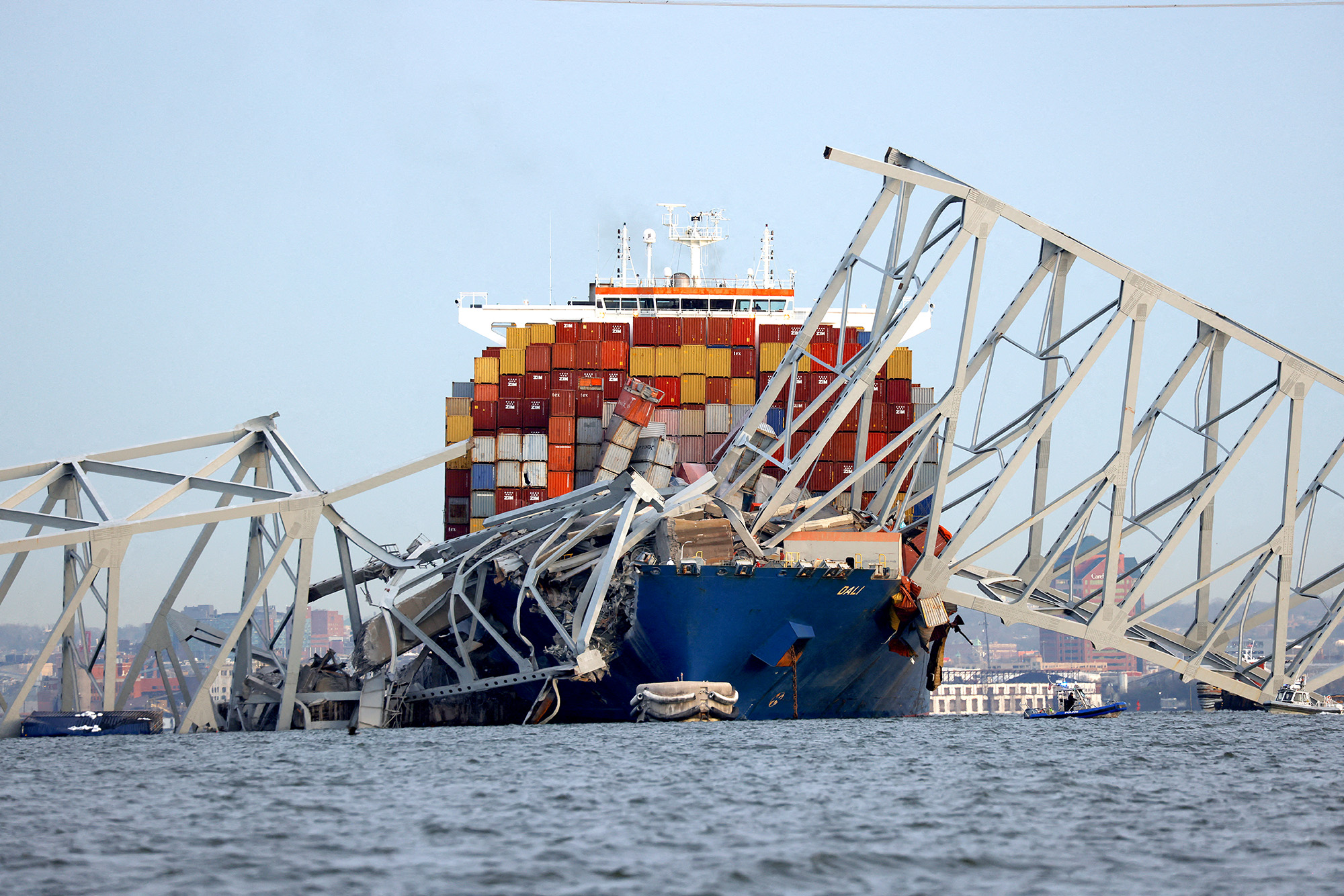
The Singaporean-flagged cargo ship that struck the Francis Scott Key Bridge in Baltimore Tuesday altered course and veered toward a pillar shortly before impact, a CNN analysis of MarineTraffic ship-tracking data confirms.
It’s unclear what caused the ship to crash into the bridge or why its lights were flickering. CNN has reached out to the National Transportation Safety Board to inquire about a possible power failure.
The container ship DALI, which was en route to Colombo, Sri Lanka, begins to change course toward the bridge’s pillar at 1:26 a.m. local time, striking the bridge at 1:28 a.m. ET, according to MarineTraffic data and video from the scene. Video from 1:25 a.m. ET shows a plume of dark smoke billowing from the ship. DALI's lights flicker at least twice before the incident.
In video, as it navigates down the Patapsco River, the ship’s lights can be seen going out at 1:24 a.m. ET, before turning back on, and then flickering off and on again between 1:26 a.m. ET and 1.27 a.m. ET, just before it hits the bridge.
Maryland transportation secretary says contractors were working on bridge at time of collapse
From CNN's Antoinette Radford
Maryland State Transportation Secretary Paul Wiedefeld told reporters there were workers on the Francis Scott Key Bridge at the time of its collapse.
"We know there were individuals on the bridge at the time of the collapse, working on the bridge, contractors for us," he said at a news conference Tuesday morning.
Wiedefeld said the workers were "basically doing some concrete deck repair," but said they did not know how many vehicles were involved.
He added that the transport authority has set up a facility for family members of those who were believed to be on the bridge at the time of its collapse.
Baltimore fire chief: Sonar has detected the presence of vehicles submerged in the water
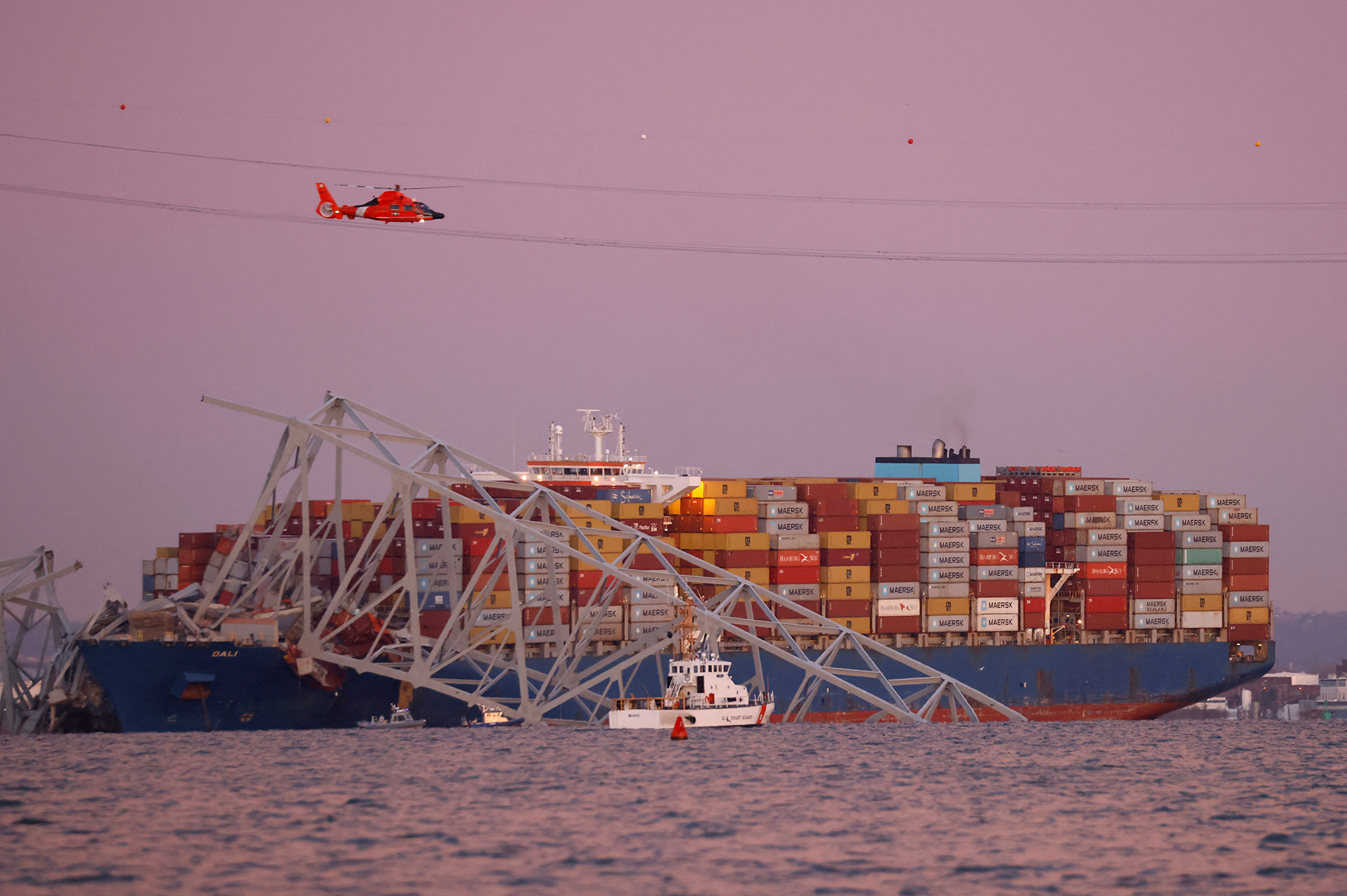
Baltimore Fire Chief James Wallace says authorities have detected vehicles submerged in the water.
“Our sonar has detected the presence of vehicles submerged in the water,” said Wallace at a news conference on the collapse of Francis Scott Key Bridge. “I don't have a count of that yet.”
He said emergency services are using sonar, drones and infrared technology as a part of their search for people and vehicles who may have fallen from the Key Bridge into the Patapsco River.
No indication of "terrorism" or intent in Baltimore bridge collapse, police chief says
From CNN’s Andy Rose

Baltimore Police said there was no evidence that the ship collision that caused the collapse of the Francis Scott Key Bridge was intentional.
“There is absolutely no indication that there's any terrorism, that this was done on purpose,” Chief Richard Worley said at a news conference.
The FBI said that it was joining the investigation into the cause of the collision.
Rescue crews have determined there are vehicles in the Patapsco River following the bridge collapse.
“Our sonar has detected the presence of vehicles submerged in the water,” said Fire Chief James Wallace. “I don't have a count of that yet.”
Wallace said they are waiting to make sure that the ship is secure and stable before investigators board it.
“Never would you think that you would see, physically see, the Key Bridge tumble down like that,” Mayor Brandon M. Scott said.
Cruises, cars and commodities: What to know about the Port of Baltimore
From CNN's Mark Thompson and Hanna Ziady
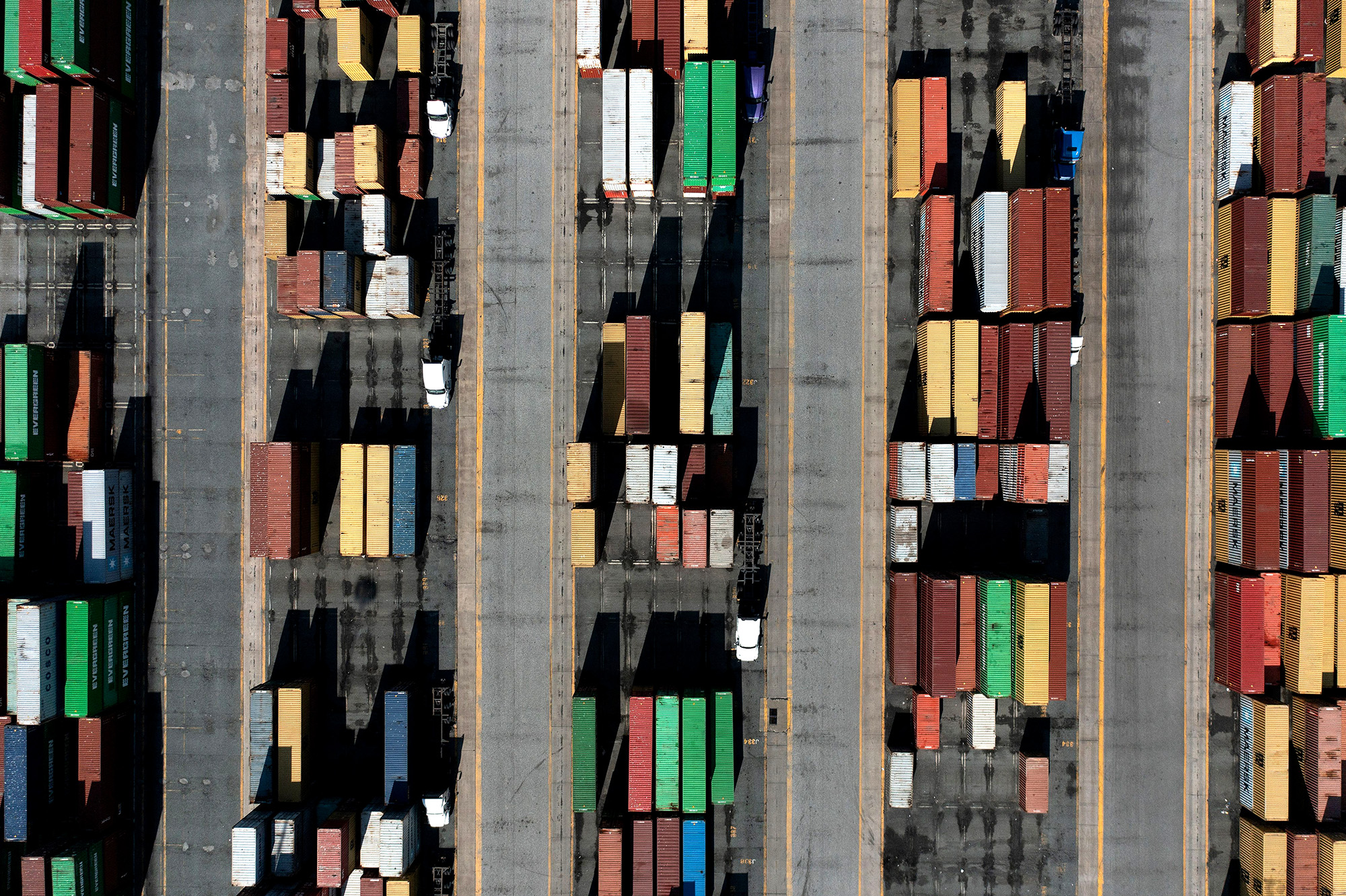
The collapse of the Francis Scott Key Bridge over the Patapsco River outside the Port of Baltimore threatens to disrupt shipping operations at a major US trade hub for autos, container traffic and commodities. Baltimore also has a cruise terminal.
Closer to the Midwest than any other port on the East Coast, Baltimore ranks first in the United States for autos and light trucks, handling a record 850,000 vehicles last year. It was also the leading port for farming and construction machinery, as well as imported sugar and gypsum. It was second in the country for exporting coal.
Overall, Baltimore ranks as the 9th biggest US port for international cargo, handling a record 52.3 million tons, valued at $80.8 billion in 2023.
“The immediate focus is the rescue operation, but there will clearly be a highly-complex recovery phase and investigation to follow and we don't know what impact this will have on operations at the Port of Baltimore," said Emily Stausbøll, market analyst at Norway-based shipping analytics company Xeneta.
“While Baltimore is not one of the largest US East Coast ports, it still imports and exports more than one million containers each year so there is the potential for this to cause significant disruption to supply chains," she added.
Baltimore's cruise terminal serves ships operated by Royal Caribbean, Carnival and Norwegian. Cruises carrying more than 444,000 passengers departed from the port last year.
According to the Maryland state government, the port supports 15,330 direct jobs and 139,180 jobs in related services.
Rescue crews looking for at least seven people in Baltimore bridge collapse
Rescue operations are underway near the wreckage of the Francis Scott Key Bridge in Baltimore, as crews look for people who fell into the Patapsco River.
“We are still very much in an active search and rescue posture at this point, and we will continue to be for some time,” Wallace added.
Baltimore Fire says two people have been rescued from the river – one who was uninjured, and another in hospitalized “very serious condition.”
“This is an unthinkable tragedy,” Mayor Brandon Scott said. “We have to first and foremost pray for all of those impacted.”
Ship that collided with Baltimore bridge was chartered by Danish shipping company Maersk
From CNN's Alex Stambaugh in Hong Kong

The container ship that collided with the Francis Scott Key Bridge in Baltimore on Tuesday was chartered by Maersk and carrying their customers' cargo, the Danish shipping company told CNN.
"We are horrified by what has happened in Baltimore, and our thoughts are with all of those affected," The company said in its statement.
The company, which has a full name of A.P. Moller - Maersk, said no company crew and personnel were onboard the vessel. It said the ship, DALI, is operated by charter vessel company Synergy Group.
"We are closely following the investigations conducted by authorities and Synergy, and we will do our utmost to keep our customers informed," the statement said.
CNN is attempting to contact the owner and managers of the ship, including Synergy.
FBI Baltimore on the scene at the Key Bridge
FBI Baltimore personnel are on the scene at the Francis Scott Key Bridge, they have said in a post on X.
The agency said it was working "side by side with our local, state and federal partners."
Baltimore fire emergency chief says 2 people saved from water after Key Bridge collapse
The Baltimore Fire Department Chief James Wallace says authorities rescued two people from the water this morning, one without injury and the other who has been transferred to hospital in a serious condition.
Authorities are continuing their search for upwards of seven people, Wallace says. But, he says that number could change as it is a "very large incident." Earlier on Tuesday, an official said as many as 20 people could be in the water.
Wallace added that the crew remains on board the ship, and are communicating with the US Coast Guard. He added that emergency services are looking into reports that there were workers on the bridge at the time of the incident.
Speaking at the press conference, Baltimore Mayor Brandon Scott also described the incident as an “unthinkable tragedy,” and offered his prayers for all those affected, as well as his thanks to first responders.
Please enable JavaScript for a better experience.

IMAGES
VIDEO
COMMENTS
It takes into consideration "reported" sail area, displacement and length at waterline. The higher the number the faster speed prediction for the boat. A cat with a number 0.6 is likely to sail 6kts in 10kts wind, a cat with a number of 0.7 is likely to sail at 7kts in 10kts wind. KSP = (Lwl*SA÷D)^0.5*0.5
Westwind 24: Boat; Displacement: 4,630 lb (2,100 kg) Draft: 5.50 ft (1.68 m) with centreboard down: Hull; Type: monohull: Construction: fibreglass: LOA: ... The Westwind 24, also called the Paceship P 24, is a Canadian trailerable sailboat that was designed by Ted Hood as a cruiser and first built in 1966.
Paceship Westwind 24 is a 23′ 11″ / 7.3 m monohull sailboat designed by Ted Hood and built by Paceship Yachts Ltd. starting in 1966. ... The lower a boat's ratio is, the less power it takes to drive the boat to its nominal hull speed or beyond. Read more. Formula. D/L = (D ÷ 2240) ÷ (0.01 x LWL)³ D: Displacement of the boat in pounds ...
Paceship began as Industrial Shipping Company Limited of Mahone Bay, Nova Scotia, a builder of small plywood speedboats. When the plant was rebuilt after a fire in 1956, it became one of the earliest manufacturer of small fiberglass runabouts and sailboats. The line soon expanded to include larger sailboats which they began marketing under the ...
The Westwind 24 paceship is a 23.92ft masthead sloop designed by Ted Hood and built in fiberglass by Paceship Yachts Ltd. since 1966. The Westwind 24 paceship is a heavy sailboat which is a reasonably good performer. It is very stable / stiff and has a good righting capability if capsized. It is best suited as a coastal cruiser.
In any case, the PY26's generous beam does provide a good deal of initial stability. Reefing will begin in about 15 knots of wind. The standard boat was fitted for outboard propulsion, with a transom bracket and gas tank stowage. Typical outboards used range from 7.5-hp. to 9.9-hp.
Paceship began as Industrial Shipping Company Limited of Mahone Bay, Nova Scotia, a builder of small plywood speedboats. When the plant was rebuilt after a fire in 1956, it became one of the earliest manufacturer of small fiberglass runabouts and sailboats. The line soon expanded to include larger sailboats which they began marketing under the Paceship name around 1962. The company was ...
Paceship East Wind 25. 1962 • 7.5 m. East Wind 24 is a 24′ 6″ / 7.5 m monohull sailboat designed by G. William McVay and built by Paceship Yachts Ltd. between 1962 and 1971.
The Westwind 24 is a small sailboat designed by the American maritime architect Ted Hood in the mid sixties. The Westwind 24 is built by the Canadian yard Paceship Yachts Ltd. (CA). Here we would have liked to show you nice photos of the Westwind 24.
The Westwind 24, also called the Paceship P 24, is a Canadian trailerable sailboat that was designed by Ted Hood as a cruiser and first built in 1966. [1] [2] [3] The design was built by Paceship Yachts in Canada , starting in 1966, but it is now out of production. [1] [3] [4]
28' Corsair Marine F-28CC Lake Tahoe, CaliforniaAsking $74,900. 25' catalina 250 Wing Keel WEST SUNBURY, PennsylvaniaAsking $19,000. 34' Hunter 34 Forked River NJ, New JerseyAsking $22,500. 27' Com-Pac Yachts Com-Pac 27-2 Pensacola, FloridaAsking $24,500.
Location, sailing experience, and weather conditions all come into play when picking the perfect sail. Two mainsails made for two Paceship 24 Westwind's in California and Florida will have different designs, sailcloth, and options based on what is best for the sailor. Taking measurements is easy. All sailors work alongside our measurement ...
1973 Paceship P29. US$14,335. ↓ Price Drop. Sunnybrook Yachts | Chester, Nova Scotia. Request Info. <. 1. >. * Price displayed is based on today's currency conversion rate of the listed sales price.
The 1973 Paceship Westwind 24 sailboat has a fiberglass hull and has an overall length of 23.92 feet (sometimes referred to as LOA). The width (or beam) of this craft is 80 inches. This boat is rigged as a Sloop. The sail area for the sailboat is 304 square feet. The displacement for the boat is approximately 4630 lbs.
The Paceship 23, American 26, Yankee Pacific Dolphin 24, and Aquarius 23 represent different solutions to the problem of easy launching. By. Darrell Nicholson - ... and we spent a good deal of time sailing with them, including several overnight crossings of Lake Michigan. The boat handled well, was reasonably quick on a reach, and had more ...
PACESHIP preowned sailboats for sale by owner. PACESHIP used sailboats for sale by owner. Home. Register & Post. View All Sailboats. Search. Avoid Fraud. ... 24' Corsair Dash 750 MKII Sadler Point Marina Jacksonville, Florida Asking $66,200. 23' Com-pac 23 Havelock, North Carolina Asking $44,500.
There is rumored to be some sailboats produced by the Plycraft company as well. The Paceship boats were first built by Industrial Shipping Company Limited of Nova Scotia (ICS). The Plycraft speedboats were the original products built by ISC in the original Mahone Bay plant until it burned down in 1956.
A massive cargo ship crashed into the Francis Scott Key Bridge, a major bridge in the Baltimore harbor, early Tuesday morning, leading to a near-total collapse of the span.. A search-and-rescue ...
Police say one person has died and two people are still missing after a fishing boat with five people onboard capsized near Port Lincoln yesterday. ... 24m ago 24 minutes ago Tue 26 Mar 2024 at 8 ...
Paceship PY 23 is a 22′ 6″ / 6.9 m monohull sailboat designed by Raymond Hunt (C.R. Hunt & Assoc.) and John Deknatel and built by AMF Corp. and Paceship Yachts Ltd. between 1973 and 1981. ... 24 ′ 0 ″ / 7.3 m E 7 ... Sail area in square feet, derived by adding the mainsail area to 100% of the foretriangle area ...
The Francis Scott Key Bridge in Baltimore, Maryland collapsed Tuesday into the Patapsco River after it was struck by a large cargo ship. The bridge's collapse has prompted huge emergency response ...
Notes. The PY 26 was built in Mahone Bay, Nova Scotia, until 1977, when production was taken over by the AMF Corporation of CT (USA). In the early 1980s, Tanzer Yachts obtained the molds for this boat and manufactured and marketed it as the TANZER 27. A keel/centerboard version also exists.
Baltimore's Francis Scott Key Bridge collapsed after it was struck by a large ship, according to video obtained by CNN. Hear the 911 dispatch the moment it happened.
The boat overturned overnight around Spilsby Island, 45 kilometres east of Port Lincoln in the Spencer Gulf. Two survivors — a 44-year-old man and a 13-year-old boy, both from the Adelaide ...
In video, as it navigates down the Patapsco River, the ship's lights can be seen going out at 1:24 a.m. ET, before turning back on, and then flickering off and on again between 1:26 a.m. ET and ...
24.00 ft / 7.32 m: E: ... Also called PACESHIP PY 23. Fin keel version - PY 23K (MORC): Draft: 3.75' Ballast: 900 lbs. ... Like the LWL, it will vary with the weights of fuel, water, stores and equipment. A boat's actual draft is usually somewhat more than the original designed or advertised draft. For boats with adjustable keels ...
It takes into consideration "reported" sail area, displacement and length at waterline. The higher the number the faster speed prediction for the boat. A cat with a number 0.6 is likely to sail 6kts in 10kts wind, a cat with a number of 0.7 is likely to sail at 7kts in 10kts wind. KSP = (Lwl*SA÷D)^0.5*0.5
A few boats are known to have been built by Coleman Boat Co. The original molds were sold to Metalmast Marine where 5 more were completed in the early 70's. Paceship Yachts of Canada turned out their own version, the PACESHIP 32 (Ad shown in 1966). (By 1973, Paceship was calling this yacht the TRIPP 32.) Dimensions shown are from a Paceship ...